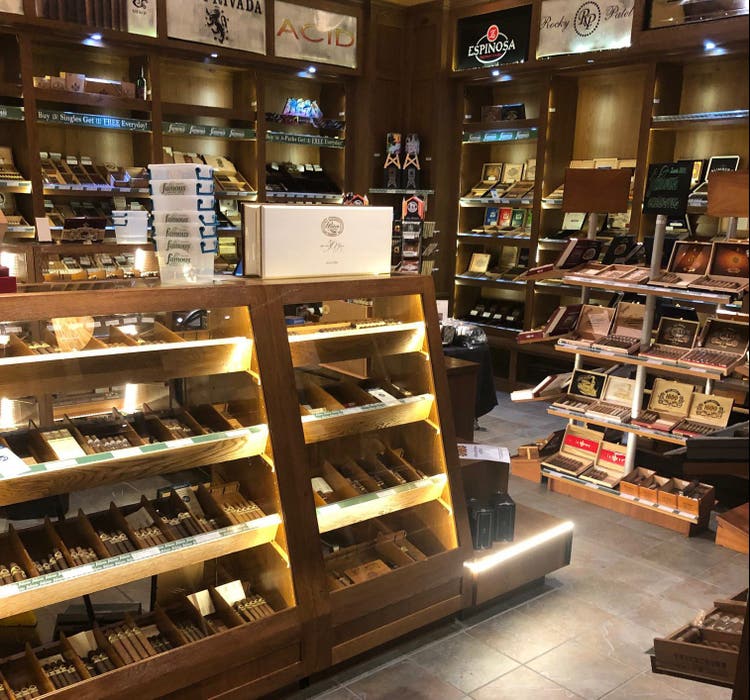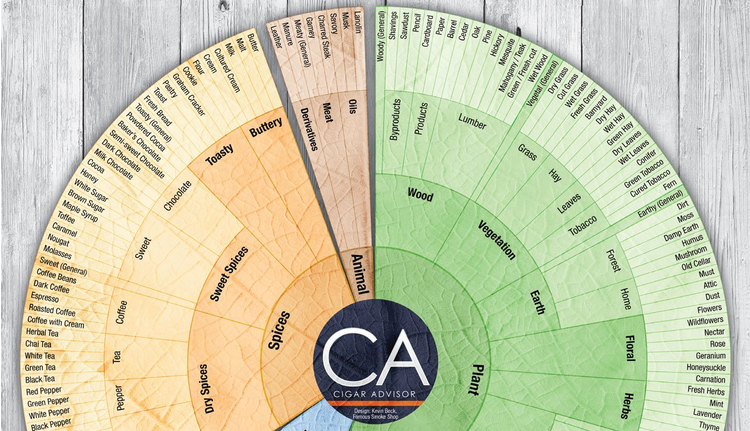
The 5 Most Common Flavors You’ll Find in Your Cigar
Cigar Tasting: The 5 Most Common Flavors You’ll Find in Your Smoke
Updated April 2021
You know how to smoke a cigar. But how are you at tasting a cigar?
Even with a little cigar experience, you’re probably able to pick out a flavor or two.
The great gag has always been, “How do I know what leather tastes like? It’s not like I’m gonna chew on my wallet…” That “taste of” something is a sensory experience that’s actually spread out over your taste buds and your nose. The best way to describe it is when you smell something and can almost taste it in the back of your throat.
The bottom line: Taste is subjective. Always has been, always will be. And if you’re satisfied with knowing that your cigars taste “good” or just like burning tobacco, you are 100% in the right to enjoy your smokes as you see fit. On the other hand, if you’re looking to improve your ability to pick out the nuances in your cigar’s flavor profile, this is a place to start.
How to Taste a Cigar
You can already identify one taste: tobacco. It’s a legit spot on the flavor wheel, and you know it because it’s the scent that hits you the moment you open the lid on a fresh box of cigars, or walk into our humidor at Famous Smoke Shop.
Different areas of your tongue and palate will pick up different flavors. For instance, anything with a salty taste will activate the sides of your tongue. Sweet is on the tip, and spice is farther back.
When the cigar’s taste is combined with attributes like body, strength and aroma, it forms the cigar’s flavor profile.
Whenever I review a cigar, I cut the cap off and take a couple of cold draws. That is, a few puffs on it before I light it. That gives me a taste of the raw flavors from the tobaccos; it’s also a pretty good indicator of some flavors I might taste after I light it.
After you light the cigar, take a draw. Swirl the smoke around in your mouth – maybe even chew it a little. As it lingers, the smoke will stimulate certain parts of your mouth. You might start detecting some basic flavors, just based on what part of your tongue is “lighting up.” Exhale slowly; as you do, your taste buds should be on the lookout for some flavors becoming more apparent as the smoke goes out.
As you smoke, remember to pace yourself. Smoking too fast will taint the flavors, giving them a charred and bitter edge. If your cigar burns too slow, it may go out; relighting it may give your stick a funky taste, too.
We borrowed the term “finish” from the wine world, where it’s used to describe how much and how long the taste or flavors linger in your mouth after wine is tasted. In our case, it’s how long after you’ve blown the smoke out of your mouth. Sometimes you’ll pick out an actual taste, like leather, cocoa, or pepper. Other times, you’ll just sense the heaviness of the cigar’s body left over on your taste buds.
All cigars have different lengths of finish: short, medium or long. And it depends on the strength and complexity of the cigar. Mellow cigars, like young wines, usually have a short finish. Stronger, more full-bodied and complex cigars will stick with you for up to a minute or more – that’s a long finish.
Retrohaling a Cigar
You don’t realize how much your nose plays a role in the sense of taste, until you pinch your nose closed. And many blenders will tell you that you’re not fully tasting the cigar unless you retrohale it. Retrohaling is expelling the smoke that’s in your mouth by pushing it out through your nose, which is loaded with sensory receptors. It takes a little practice, and you can see how it’s done here:
Using a Cigar Flavor Wheel
If your taste buds are becoming aware of new flavors, but you’re having trouble identifying them – this is a great opportunity to start using a cigar flavor wheel. Our free cigar flavor wheel is broken into groups of related tasting notes. So when your taste buds get accustomed to tasting more than just burning tobacco, you can pinpoint the flavors like earth, wood and leather – and even more accurately, what kind of wood or earth.
Here again, taste is subjective: a tasting note like mineral or charred steak may appeal to some, but not to others…although pretty much everyone agrees that astringent or synthetic tastes aren’t what you’re looking for in a cigar. Flavors like those are usually a sign that something went wrong in the fermenting or aging process.
The more flavors you can identify on the wheel while you smoke, the more complex the cigar is; if the tastes are more intense, we’d call it full-flavored, too.
Five Common Cigar Flavors
Each category of flavor below is a basic overview of the most common flavors you’ll taste. These should give you a jump-off point to understand how to taste your cigar, and to identify what you like about what you’re smoking.
The more cigars you taste and the more you hone your senses, you’ll pick up on even more of the following flavors…

Probably the most common taste in a cigar, mostly because tobacco – like a tree – is a plant. It also helps that you’re used to the smells and sensations of cut wood: cedar (like your humidor), oak barrels, and anything else you might have played around with in shop class. This includes wood in its various states: dry, wet, cut, sawdust and campfires, to products like cardboard, teak furniture and sharpened pencils. You know what these smell like, and that makes those sensations easy to identify.
We can also include pretty much anything that commonly grows outside the garden: tobacco, moss, hay, grass…but the most common is cedar, a taste that’s often imparted by the wood used in the factories’ aging rooms. Naturally woody tastes are often associated with Dominican and Nicaraguan tobaccos; Connecticut leaves tend to have more of the grassy and hay-like flavors. A cigar like this Siboney Reserve Connecticut by Aganorsa has both.

Basically speaking, spice is burn – but a spicy cigar can offer a range of tastes as wide as your deluxe spice rack. The Level 5 Thai stuff is housed in this category; so are red, white and black pepper, cinnamon, licorice, ginger, vanilla, cumin, anise and a huge range of herbs and baking spices. Even chocolate and coffee can fall into this category. You’ll usually taste these on the tip of your tongue – but spice can be found all over your palate depending on how intense it is and if it is more fiery or sweet.
Spice is a hallmark of Central American tobaccos, and blenders like AJ Fernandez have made it their trademark with cigars like Enclave. Don Pepin and Jaime Garcia (My Father) have done it just as well, if not better.

So what does earth taste like? Since you’re not likely to shovel a pile of dirt in your mouth, picture this…the smell you can almost taste as the first drops of rain hit dry rocks. It’s called petrichor. Another would be the sensation of being in a damp forest or a musty basement, opening a bag of fresh topsoil, or that wet-but-dry sensation if you’ve ever handled wet clay. Any of those thoughts should trigger a memory of earthiness that you can virtually taste in the back of your throat.
In addition to being sweet, fuller-bodied Maduros tend to exhibit some earthy character. Especially San Andres and Mata Fina, like the wrapper on Herrera Esteli Brazilian Maduro – they tend to offer a gritty earthiness that, when blended with fuller bodied tobaccos, will stimulate your entire palate with rich taste.

A fruity flavor can be found in just about any type of cigar at any strength level, so this one ends up being somewhat common; intensity, however, is a different story. Here’s the part of the flavor wheel that includes citrus (lemon, lime, orange), tree fruits (like figs, black cherries or the savory taste of pear) and berries. This category also includes dried and fermented fruits: raisin, jam, even the tannic taste that will remind you of red wine. If our palates are different, you might pick some of these up as spice – it’s more of a clean, crisp sweetness than you might experience with the chocolate, caramel and cookie tastes from the spice part of the wheel.
While dried fruit is a common thread among cigars, I tend to find a hint of citrusy, orange peel flavor in cigars with sun grown wrappers. The Perdomo 20th Anniversary Sun Grown is the first one that comes to mind to feature that zesty taste more prominently (and intensely) than most.

I’m not really a nut guy, so I’ll be the first to admit that I still have trouble differentiating one nut from another when it comes to flavor and characteristics. There’s cashew, almond, peanut, chestnut, hazelnut…it’s common for these flavors to take on a toasty or buttery quality (think roasted nuts), or even the saltiness of macadamias or peanuts. A cigar that has a nutty taste often has a smoke with a creamy feel, and that’s some of the more medium-bodied Connecticut wrapper cigars.
While a bag of street cart chestnuts is not at all my thing, I do know that a great example is the Rocky Patel Vintage 1999. It’s a velvety smooth cigar that incorporates a lot of nutty flavor in the middle of the smoke, along with some of those buttery and toasty qualities I mentioned.
Three Last Things
A few points before we go fire up another cigar:
First, a reminder of how subjective cigars are in terms of flavor. While we should both taste the cigar’s base flavors that the blender intended, it’s ok if you and I don’t sense the same nuances and complexities. Or, if you and I sense the same flavor, but we don’t interpret it the same. No one is wrong, it just shows we’re wired a little differently.
Second is that it takes practice to learn to taste cigars, and it helps to have a clean palate. But the more you taste these flavors, the more readily you’ll be able to identify them. And let’s be honest – this is the kind of practice you really don’t mind doing.
Lastly, the tasting notes you really like (and the ones you really don’t) are going to be the easiest flavors to pick out. Don’t be surprised if you develop the skill to identify those first.
Let us know with a comment below what flavors you look for in a good cigar!







